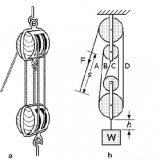Robotic MECHANISMS – INCLINED PLANE 51004
An inclined plane is a flat supporting surface tilted at an angle, with one end higher than the other, used as an aid for raising or lowering a load. The inclined plane is one of the six classical simple machines defined by Renaissance scientists. Inclined planes are widely used to move heavy loads over vertical obstacles; examples vary from a ramp used to load goods into a truck, to a person walking up a pedestrian ramp, to an automobile or railroad train climbing a grade.
Moving an object up an inclined plane requires less force than lifting it straight up, at a cost of an increase in the distance moved. The mechanical advantage of an inclined plane, the factor by which the force is reduced, is equal to the ratio of the length of the sloped surface to the height it spans. Due to conservation of energy, the same amount of mechanical energy (work) is required to lift a given object by a given vertical distance, disregarding losses from friction, but the inclined plane allows the same work to be done with a smaller force exerted over a greater distance.
The angle of friction, also sometimes called the angle of repose,is the maximum angle at which a load can rest motionless on an inclined plane due to friction, without sliding down. This angle is equal to the arctangent of the coefficient of static friction μs between the surfaces.
Inclined Plane Example
The inclined plane, shown in Fig. , has an incline length l (AB) = 8 ft and a height h (BC) = 3 ft. The inclined plane permits a smaller force to raise a given weight than if it were lifted directly from the ground.
For example, if a weight W of 1000 lb is to be raised vertically through a height BC of 3 ft without using an inclined plane, a force F of 1000 lb must be exerted over that height. However, with an inclined plane, the weight is moved over the longer distance of 8 ft, but a force F of only 3/8 of 1000 or 375 lb would be required because the weight is moved through a longer distance. To determine the mechanical advantage of the inclined plane, the following formula is used:
F = W sin θ
sin θ = height h / lenght l
where height h = 3 ft, length l = 8 ft , sin θ = 0,375, and weight W = 1000lb
F= 1000 x 0,375
F = 375 lb
Mechanical advantage MA = load / effort = W / F = 1000 / 375 = 2,7
Frictionless Inclined Plane
If there is no friction between the object being moved and the plane, the device is called an ideal inclined plane. This condition might be approached if the object is rolling, like a barrel, or supported on wheels or casters. Due to conservation of energy, for a frictionless inclined plane the work done on the load lifting it, Wout, is equal to the work done by the input force, Win
Work is defined as the force multiplied by the distance it moves. The work done on the load is just equal to its weight multiplied by the vertical distance it rises, which is the “rise” of the inclined plane
The input work is equal to the force Fi on the object times the diagonal length of the inclined plane.
Substituting these values into the conservation of energy equation above and rearranging
To express the mechanical advantage by the angle θ of the plane,
So
So the mechanical advantage of a frictionless inclined plane is equal to the reciprocal of the sine of the slope angle. The input force Fi from this equation is the force needed to hold the load motionless on the inclined plane, or push it up at a constant velocity. If the input force is greater than this, the load will accelerate up the plane; if the force is less, it will accelerate down the plane.
Resources:
Youtube Video : http://youtu.be/igrMlzHL-qg
Youttube Video: http://youtu.be/yagD_4UMxrg










